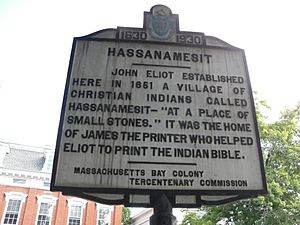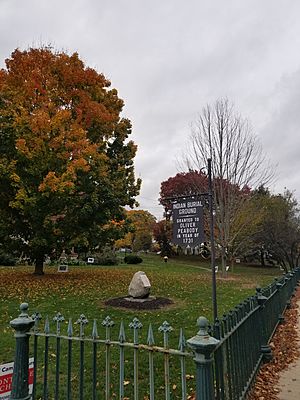Praying town facts for kids
Praying towns were special settlements created by English colonists in New England between 1646 and 1675. Their main goal was to teach local Native Americans about Christianity. The native people who moved into these towns were known as Praying Indians. These villages were a big effort to convert Native Americans in the early Thirteen Colonies. They even led to the creation of the first books printed in an Algonquian language, including the first Bible printed in British North America.
During King Philip's War (1675-1678), many praying towns became empty. This happened partly because Praying Indians were forced to move to Deer Island. Many of them sadly died there during the winter of 1675. After the war, many of the original praying towns were never rebuilt. However, some praying towns did continue. Today, many Native American groups in New England trace their history back to these towns. These include the Mashpee Wampanoag, the Ponkapoag and Natick Massachusett, and the Chaubunagungamaug and Hassanamisco Nipmuc.
Contents
The Start of Praying Towns
John Eliot was an English colonist and a Puritan minister. He played a very important part in setting up praying towns. In the 1630s and 1640s, Eliot worked with Native Americans who spoke both English and Algonquian languages. These helpers included John Sassamon and Cockenoe. They helped Eliot translate several Christian books, including the Bible, into the Massachusett language.
Eliot learned enough Massachusett to preach. He started sharing his beliefs with the Neponset band of Massachusetts people. He was first well-received in 1646 when preaching at Nonantum. This place is in what is now Newton, and its name means "place of rejoicing" in Massachusett. This sermon led to a friendship with Waban (around 1604–1685), a Nipmuc leader. Waban became the first Native American in Massachusetts to become a Christian.
News of Eliot's work reached England. In 1649, Cromwell's Parliament passed a law. This law created the Society for the Propagation of the Gospel in New England. This society would help pay for an Indian College at Harvard. It also funded a printing press in Cambridge. This press was used to print Eliot's Christian writings in Massachusett.
Between 1651 and 1675, the Massachusetts General Court (the government of the Massachusetts Bay Colony) created 14 praying towns. The first two towns were Natick (started in 1651) and Ponkapoag (started in 1654). These towns were mostly home to Massachusett people. Wamesit was set up for the Pawtucket, who were part of the Pennacook group. Other praying towns were established as Nipmuc outposts. These included Wabquasset, Quinnetusset, and Maanexit. Quaboag, which was far from the other settlements, was never fully established. This was due to the start of King Philip's War.
List of Praying Towns
- Further information: Praying Indians of Natick
Here is a list of some of the praying towns that were established:
Massachusetts Bay Colony
- Natick
- Ponkapoag
- Hassanamessit
- Chaubunakongkomun (Chaubunagungamaug)
- Manexit
- Manchaug
- Magunkaquog
- Nashoba
- Okommakamesitt
- Pakachoag
- Quaboag
- Quinnetusset
- Waushakum
- Wabquasset
- Wamesit
Plymouth Colony
The Plymouth, Connecticut, and Rhode Island Colonies also created praying towns. This list comes from a 1674 record by Puritan pastor Daniel Gookin.
- Meeshawn
- Potanumaquut
- Manamoyik
- Sawkattuket
- Nobsquassit
- Matakees
- Weequakut
- Satuit
- Pawpoesit
- Mashpee
- Wakoquet
- Codtaninut
- Ashimuit
- Weesquobs
- Pispogutt
- Wawayontat
- Sokones
- Cotuhkikut
- Namasket
Other praying towns included Gay Head, Nantucket, Herring Pond (in Plymouth), and Nukkehkummees (in Dartmouth).
Connecticut
Three praying towns were set up in Connecticut. Maanexit (a Nipmuc word meaning "where we gather") is thought to have been where Fabyan (Thompson, Connecticut) is today. Quinnatisset (meaning "little long river") was six miles south of Maanexit. Wabaquasset (meaning "mats for covering the house") was later replaced by what is now Woodstock, Connecticut. These three towns were home to between 100 and 150 Nipmuc tribal members.
Why Praying Towns Were Created

The Puritan missionaries wanted Native Americans to become Christians. They also hoped Native Americans would adopt European ways of life. This included European customs, clothing, and farming methods. They expected Native people to give up their own cultural traditions and religions. Anything the colonists saw as "uncivilized" was to be changed. The Massachusetts General Court supported Eliot's work and helped create more praying towns.
Different Ways of Conversion
The Puritans wanted Native Americans to fully change their beliefs. This was different from how Catholic Jesuits in Canada approached conversion. The Jesuits tried to add Christianity to the Natives' existing beliefs, not replace them entirely. They learned Native American languages. They also found ways to connect Christian ideas to the Native religions.
While some Native Americans quickly accepted Christianity, others did not like the idea of a full change. The process was often difficult. However, there were many reasons why some Native people chose to convert.
Seeking Safety from Conflict
Some Native Americans converted because they hoped it would make the colonists trust them more. They also hoped it would help them keep their land rights. Due to conflicts between tribes and with colonists, some Native Americans saw praying towns as safe places from war. Other tribes had been greatly reduced by disease and hunger. They might have looked to Christianity and the Puritan way of life for answers to their suffering. Their traditional beliefs did not seem to have helped them in these hard times. Other Native people joined the towns because they had no other good choices for their economy or politics.
After King Philip's War ended in 1677, the General Court closed 10 of the original 14 towns. The remaining towns were put under the watch of colonists. However, many Native communities did survive. They kept their own religious and education systems.
Challenges of Assimilation
While praying towns had some successes, they never reached the level John Eliot had hoped for. The Puritans were happy with the conversions. But Praying Indians were still seen as second-class citizens. They never gained the full trust or respect from colonists that they hoped conversion would bring.
Some historians also say that Native Americans found it hard to adjust to the colonial society. Native societies were built on relationships and helping each other. Colonial society was more structured and formal. This difference made it hard for Native people to understand the colonists' systems. John Eliot may not have seen the need for changes that would make the transition smoother.
Self-Governing Communities
Other historians have noted that the Praying Indian communities governed themselves. They elected their own leaders and officials. This system was similar to their traditional ways of governing before Europeans arrived. English-style jobs, like constables and Justices of the Peace, were introduced. But these jobs often had names that were the same as traditional Native American roles. The elected officials were often chosen from the existing tribal leaders. In some cases, Native hereditary rulers kept their power.
The communities also used their own languages for official business. Many legal and administrative documents written in Native languages still exist today. However, their self-government slowly decreased during the 1700s and 1800s. Their languages eventually disappeared. Most of the original "Praying Towns" declined over the centuries. This was due to diseases and the loss of their shared land.



